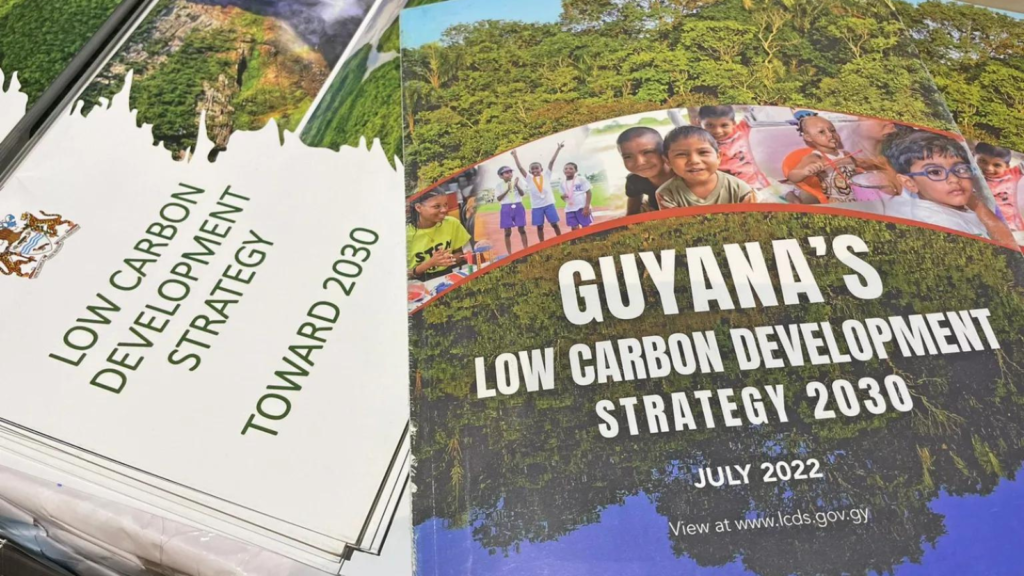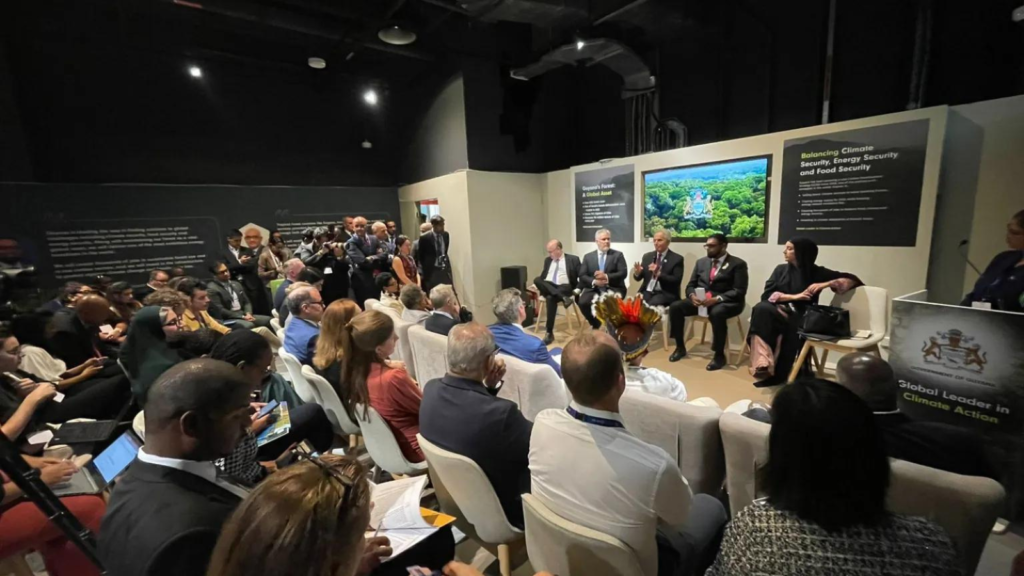Sign up for the COP28 Daily News Tracker for a comprehensive analysis of the climate summit and coverage from our Fellows, right in your inbox.
Why should anyone pay attention to Guyana’s Low Carbon Development Strategy or the LCDS?
That was the question President Dr. Irfaan Ali, Vice President Dr. Bharrat Jagdeo and other leaders from around the world tried to answer on Friday at the country’s side event at this year’s United Nations climate talks called COP28.
Is it because the strategy has been used to help Guyana get money to keep its forests intact? Or is it because the strategy outlines how Guyana can use its newfound oil resources to fund its transition to the use of more renewable sources of energy?
For President Ali, it’s all that and more.

“The LCDS as a model speaks to sustainability, livelihoods, sustainable job opportunities, sustainable agriculture and within the LCDS, we speak about renewable energy and transition to renewable energy.
“…it is an economic model,” he said.
President Ali and the others gathered in a small room in Building #60 of the gigantic Dubai Expo City venue. Outside, there are trees all around this building and if you aren’t comfortably oriented to the Expo City map, it is possible to walk right past Guyana’s pavilion. Those trees camouflage the Golden Arrowhead in front.
Inside, the talks are focused on trees- 18.5 million hectares of trees to be exact- and how Guyana has been sustainably managing those resources through the LCDS created more than a decade ago by the Dr. Jagdeo (who was Guyana’s President then).

Guyana’s intact forests cover about 85% of the country’s landmass. For illustrative purposes, the area of Guyana covered by the forest is equivalent to the area of England and Scotland combined. They help to trap carbon dioxide, one of the harmful greenhouse gases that contribute to climate change and bring about extreme weather events such as fires and flooding.
The tiny South American country has tried its best not to cut down those trees and use them for logging so that the land can be cleared for mining or agricultural activities. And it hasn’t done a bad job. Guyana’s annual deforestation rate averages at about 0.06%, a rate which is 90% lower than other tropical countries. Last year, it was 0.036%
Guyana earning from saving trees
While he spoke about Guyana’s forest credentials, the President also pointed out that Guyana has found ways to earn- though not nearly enough- for keeping the trees standing. In 2009, it signed a US$250 million with Norway; last year, American oil company Hess (which is producing oil in Guyana’s prolific Stabroek Block) bought Guyana’s newly-accredited carbon credits for at least US$750 million. On the latter deal, the LCDS makes it clear that 15% of all monies earned must go to Indigenous communities, the custodians of the forests.
So far, about 500 projects have started in more than 220 Indigenous communities all across Guyana using the carbon credit funds already earned from the Hess deal.

“The first thing Guyana is doing with its forests is providing a service to the world,” Melena Pollard, Toshao of River’s View told the News Room.
She is among the Guyanese Indigenous people in Dubai for COP28 and she highlighted just how her community is benefitting.
“The monies are used to help develop the village and the country at large.
“We have spent it in different sectors: youth, education, health, tourism (we refurbished our benab) and other projects that are income generating like a storage bond for (poultry) feed and a broiler project,” the Toshao said.
Now, the remaining 85% of the carbon credits go towards national priorities like beefing up sea defences as part of Guyana’s climate adaptation focus.
All that is important because, as Vice President Jagdeo put it, Guyana has been able to create a model that tackles every concern usually raised when forests and forest-saving payments are championed.
He said the country is showing how the money earned can be managed well, the carbon credits are certified by an international body (ART TREES), Indigenous people’s land rights are not being threatened and they can earn, and Guyana gets the money it needs.
“The problem globally is that we don’t see enough attention on forests. Somehow, there is a belief that forests can be saved through philanthropy or pledges like in Glasgow [at COP26],” Jagdeo lamented.
But, he said, “We believe our model [the LCDS] has answered all the questions, the things that people raise globally.”
Oil and forests: A contradiction?
As Guyana pushes this LCDS, it faces criticisms for its growing oil and gas sector. After all, that sector is notorious for emitting carbon dioxide, the very same harmful gas that Guyana’s trees help to suck out of the atmosphere.
Based on the 2023 European Commission’s Emissions Database for Global Atmospheric Research (EDGAR), Guyana’s emissions have been increasing. Between 2020 and 2022, when the country got into oil production, emissions from fuel exploitation started adding to Guyana’s total greenhouse gas emissions.

So concerns are valid.
But Guyana’s President says there is no conflict between the dual pursuit. Nor should there be for the world.
He opined that the conversation on getting to net zero by 2050 shouldn’t be on eliminating fossil fuels alone. For him, it should include the phase-out of fossil fuels like oil but also efforts to keep forests intact. And he reminded the gathering that the demand for energy remains huge- there are countries still grappling with energy poverty- and the existing supply of renewable energy just does not fill that gap.
Balancing these resources to meet developmental needs is a huge focus of the LCDS, the President said.
The country’s Vice President is a little less diplomatic and instead says such questions about Guyana’s “balancing act” irks him.

He explained that even at peak oil production (which is expected to be 1.6 million barrels of oil produced daily), Guyana would still be carbon-negative. That is, its trees would trap more emissions than Guyana is producing. Jagdeo said emissions at peak production would only be about 20% of the 154 million tonnes of carbon trapped by Guyana’s trees.
Former Prime Minister of the United Kingdom (UK) Tony Blair, who was also part of the side event, said it would be problematic for developed countries especially to tell developing countries like Guyana that they cannot harness their resources.
“They’re not going to listen to anyone who says ‘I’m very sorry we created this problem but I want you to stop’…” Blair said.
That’s why he said he supports the LCDS.
“It’s practical things that will allow us to solve this and it’s projects that will get people to put their money,” Blair told the gathering.
This story was originally published by the News Room, with the support of Climate Tracker’s COP28 Climate Justice Reporting Fellowship.